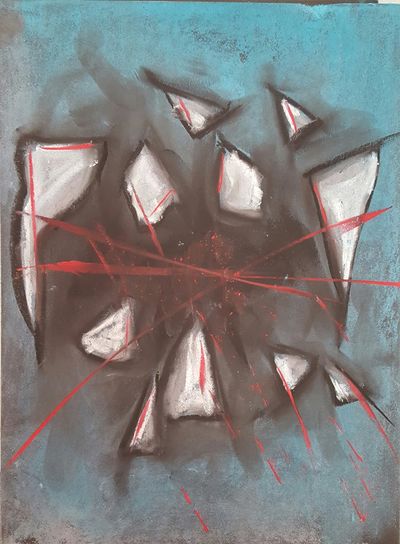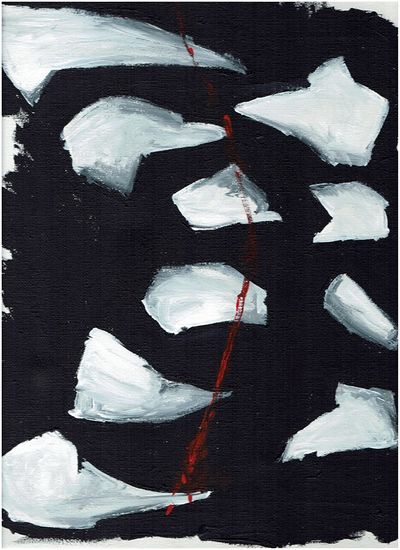Agramant
Eternal of Winter
Sobriquets
Agramant - or sometimes the Agramant - goes by a number of names. It is usually identified as male, and is commonly called The Howler or The Hunter in the Wastes. He's also known as Wendigo in some places.
Agramant is also known as the Devourer of the Fallen, and The Voice of the Pines. In Wintermark the Suaq call him Blood-on-the-Snow and the Kallavesi call him The Dream of Famine. In some old Varushkan tales he is referred to as The Whisperer or The Wastewalker; these stories focus on the belief that he tries to encourage the hungry and the lost to atrocious acts in the name of survival, or how he lures the greedy to acts of self-debasement and madness until they finally snap and become literal or figurative monsters.
In Highguard the magisters call him The Abominable One and many count him the worst of the eternals. In The Brass Coast and parts of Dawn he is sometimes called The Horned Manticore, and there are several stories that suggest the beasts of the same name are his children. In The Marches he is often mentioned as The Harvester of Graves and the superstitious spit when they mention him by any of his epithets - there are old stories that suggest that food eaten or drink drunk will cause a stomach upset while you still have the same saliva in your mouth that spoke his name.
Appearance
Agramant is sometimes depicted as a massive, hairy monster with razor-sharp claws and wide, staring eyes. He is usually shown possessing a massive mouth of shark-like teeth, and is generally pale in colour and spattered with blood. In some cases he appears as a brutish and thuggish orc wielding a club made from the legbone of a great beast.
Stargazers, Dawnish enchanters and icewalkers who have experience of dealing with Agramant claim that his most common form is that of a sturdy draughir-like being wrapped in flayed hides, usually those of a bear or stag, still dripping with blood and gore. He often wears the head of a great beast as a helmet, or crown. They say that his razor-sharp teeth and tearing-claws are quite real, however.
Agramant is almost always encountered alone.
Agramant has claimed numerous times to be the source of the draughir although there is absolutely no evidence of this claim. Those dealing with Agramant would do well to remember that he lies and he lies often.
Concerns
Agramant teaches that ultimately everyone is alone. That survival is all that matters - another breath is the only truly precious thing in creation. His twisted philosophy appears to include ideas such as the expendability of all those who are weak, and the need for the strong to prey on and devour the weak. He expresses the idea that only those with the will to power are truly aware of their place in the cosmos, and that those bound by rules, laws and the expectations of society or concern for others are little more than sheep, who deserve to be slaughtered by those with superior souls.
This eternal, like Sorin, is associated with hunger, but for Agramant it is the hunger that leads to unnatural acts of murder and cannibalism. He is the only Winter eternal who seems to actively approve of wanton acts and the consumption of the flesh of other thinking creatures for its own sake, rather than as a desperate act brought on by circumstance. He is known to use heralds and gifts to actively encourage cults and bands of murderers to perform cannibalistic feasts in his name, and in the name of proving their own superiority over the herd.
At the time of Britta's death, Agramant was the only eternal considered to be an enemy of the Empire, due to the Declaration of Enmity of the Imperial Conclave in 306YE following exposure of his involvement in no less than three cannibalistic cults dedicated to blasphemy, idolatry and heresy. The declaration was brought by the Varushkan volhov Beloslava Velkovitch. It is currently illegal to deal with him or his heralds.
The Agramant's Bargain is a magical staff. The term also means a bargain where both parties are weakened or harmed, but one of the parties is capable of enduring or mastering the pain or debilitation to the detriment of the other party.
Some thoughtful scholars suggest that Agramant is not entirely what he appears to be. There is wisdom in him, they claim. All he does is point out to his followers that they could do unspeakable things - he never coerces them. He encourages them to become monsters, but they could just as easily choose to ignore his inducements. Agramant, they say, drives his cults until they self-destruct, demonstrating the foolishness of his professed philosophy and reminding others that there are monsters in their midst who look just like they do. Agramant himself laughs at this, apparently, and changes the subject.
Boons
Agramant offers strength to those who undertake his Unspeakable Feast - usually a ritual involving the consumption of the fresh meat of a thinking being such as a human or orc. He is also believed to be especially keen to encourage the draughir to embrace their facility to gain sustenance from rotten flesh. He may provide powers associated with physical weakness, most often through the evocation of his terrible howl - the same howl that can send mortals stumbling away in terror.
He is also said to be a consummate hunter; that he can hunt not only in the Winter Realm, but can somehow hunt in the dreams of others, finding anyone who has ever known hunger or desperation. Agramant can deliver or empower many curses, and by hunting in the dreams of an enemy he can drive them slowly insane, twisting them until they turn against their neighbours attacking and slaughtering without warning; such unfortunates often believe that they have transformed into bloodthirsty beasts, free of the constraints their human scruples place on them.
He rarely uses his powers or grants them as boons unless he receives some sort of tribute in return - usually a savage murder or act of cannibalism.
Childer of the Black Drop
In 344YE or thereabouts, a cabal of magicians from the League calling themselves the Childer of the Black Drop, apparently inspired by the (possibly fictional) character Esconius of Highguard set out to learn everything they could about the hateful eternal Agramant.They committed themselves to collecting every scrap of lore they could find about the eternal, apparently hoping to find some kind of weakness that could be exploited to protect the Empire completely from his depredations. According to dusty records, all thirteen members of the cabal were - perhaps inevitably - declared sorcerers by the Imperial Conclave in Summer 354YE. In pursuit of their quest they had apparently used magic in very unwise ways - mastering rituals that drew on the power of Blood-on-the-Snow to "better understand his dark temptations". They were unrepentant, and eight of their members were killed in the resulting fracas. Five of them - Johann Perivale von Sarvos, Wilhelm Ecaso di Temeschwar, Padik Tarvin of Tassato Mestra, Tomazi duPain de Holberg, and Jodeya Watiker di Tassato Mestra - were unaccounted for. They were assumed to have fled the Empire.
In Summer 384YE, the bodies of four of them were unexpectedly discovered in a cottage in the Vardstein Vale by scouts exploring the area around Lorenzo's Deep Pockets. They had been dead for at least a month, perhaps longer, and as near as could be ascertained Johann had been poisoned with the Crimson Gate. Tomazi duPain had fallen out of a window, and hanged by his own splendid cloak. Padik Tarvin was discovered with five vicious daggers embedded in his back, but with no sign of a struggle. Wilhelm was found at the dinner table, a half-full glass of Dawnish wine still in one hand, with no sign of how he died - his body transformed to stone through use of Mark the Flesh Incorruptible, concealing the cause of death. There were place settings for five, but only four bodies. A mystery that has baffled the magistrates. Even more mysterious is the presence in the cottage of a large trunk, inlaid with weltsilver runes of Aesh, Sular, and Ophis. The trunk itself was empty. Of Jodeya Watiker di Tassato Mestra there was no sign; nor was there any sign of the Childer of the Black Drop's library (assuming it still existed).
Three days before the Autumn Equinox, a ritual suddenly appeared in Urizen lore. Treacher's Quill was apparently part of a grimoire called the Ceremonies of the Black Drop Society. Three months later, a further five rituals from that book - The Crimson Feast, Loosen the Shackles, Mark of Agramant, Thirst of the Devourer, and Unleash the Beasts Within - also entered Urizen lore.
Apparently the attendants of the Great Library are deeply uncomfortable with these rituals and their presence among Urizen lore, more due to their illegal nature than any sentimental concerns about their origin. They were apparently all submitted at the same time as Treacher's Quill, but Phaleron itself intervened to delay their appearance in lore while it pondered how best to respond. In the end they have decided to do the only thing they can; present the rituals to the Urizen as part of their lore as agreed when Urizen lore was created. The Celestial Library does not enjoy causing trouble for its Urizeni allies, but the Gift of Knowledge is available to every Imperial citizen; it cannot pick and choose who can contribute rituals via the ritual. If it is any consolation, there appear to be no further rituals waiting to enter Urizen lore relating to the Black Drop.
Around the same time that the rituals appeared, news spread that the body of Jodeya Watiker di Tassato Mestra had been found in a parador in the Jade Range "The Gecko's Nest". She had been killed during the Autumn Equinox during or immediately after a meeting with three strangers - none of them Freeborn. The night barman was present for part of the meeting but did not hear what was discussed; Jodeya dismissed him and when he returned half an hour later she was dead. He reports that the visitors were a mixed assortment - a Marcher, a Navarr, and an Urizeni, although the barman believes the Marcher left before he did. There's no way to say if they returned or not, unfortunately.
Eyewitnesses said that nobody entered or left the parador during the period Jodeya was last seen alive. The magistrates are investigating, but apart from the question of how her killers entered the parador, this seems to be a reasonably straightforward murder. Short of interrogating Jodeya herself, it seems unlikely that they will be able to find any evidence as to who the murderers were. They are interested in tracking down the mask Jodeya was wearing when she was last seen alive but which was not found with the body - but they are not holding out much hope of being able to identify it.
It's hoped that with the death of Jodeya, that is the last anyone will hear of the Childer of the Black Drop; and that no more baleful rituals from their grimoire will appear to trouble the Empire.
Beware the Agramant, my child,
When the moon is fat and the sky is clear;
Beware his grinning maw and gentle voice,
His joysome tales of warm, red meats.
Beware the Agramant, my child,
When the wind is cold and home not near;
Beware his grasping claw and whisper'd choice'
His gleesome talk of soft, dark treats.
Beware the Agramant, my child
''Beware the Agramant'', Valshok Juerdann

